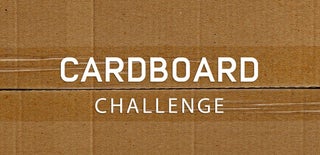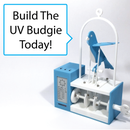Introduction: Cardboard Box Bus - for a Toy Ride
Some people unwind with knitting, videogames, cooking...I make stuff from boxes in the street.
I have a toddler, and he's loving role-play and physical models to move his toy animals/people around. Without sounding too hipster, I try to avoid buying more huge plastic sets which will get out-grown in a few months, so I've taken to junk modelling as much for economy as for recycling and reuse of stuff.
Although I did most of the making myself, the painting I left to my son, and a friend who came round for a visit. Once dry, it's been a firm favourite - with probably the best feature being the spiral staircase and the slide! (Why have busses not got slides is beyond me!?)
Although I've done 'professional card modelling' for some years while at Dyson, and have a Design Modelling website, I hope these skills are simple enough that anyone can follow and make their own cool toys and games from boxes!
Step 1: You Will Need
Most of the tools here are pretty obvious.
But I would say that I recently bought a Bosch Cordless Glue-gun. They heat up super-fast, and don't have a huge chunk of metal at the tip. And although I don't leave it unattended with my toddler watching me, I fear burns much less with this. It also dispenses much less glue in a press. (I'm not getting paid to say this. It's just ace.).
Bosch Glue Pen (LINK).
Wooden Q-tips - but bamboo BBQ skewers will do fine also.
I use a #10A Scalpel Blade by Swann & Morton (LINK). It's better than a lot of craft knives. (TIPS).
I also use a awl to help fold card, but you can use a Biro pen without ink. EXAMPLE
Step 2: Not All Boxes Are Equal
Some are better than others...
These 'slim' (~4inch high) ones are often for small, but dense fruit like nectarines, persimmons, or other exotic fruit. The Card is double corrugated, and unlike 'deep' boxes (~8inch high), (which often have stuff like melons in - which make the bottom of the box sag), these are usually still flat/un-warped. So your bus will not be bendy!
So now you know how to collect a good one, you'll find this all works so much better...
Step 3: Sketch & Cut
I googled a plan view of a Routemaster Bus, as it has the cool stairs!
You can print it out and carefully trace it, but as this was something I was casually doing in an evening, I just freestyled it.
TIP1: This is why the choice of box is quite important - if you place the box upside-down, you'll find that you can stab-through with the scalpel, and it's easier than trying the other way around.
TIP2: As with laser-cutting, but the Windows (inner portions) out before the perimeter (outline of bus). This means you have the support from the bulk of the box when doing fiddly details. Try it the other way, and you'll get more bent and buckled card. (Any missed parts, just correct on the other side).
Step 4: Mirror Side a to Side B
Trace around Side A to Side B. (You can probably see the slight change in colour of the card).
Take care to avoid duplicating the rear door twice!
Step 5: Chassis & Upper Floor
I chose to inset the wheels, but you can of course skip this, and just stick them on the outside.
To line up, I marked the approximate positions, and cut a long rectangle out for the chassis.
I also cut some pieces the fame width as the chassis, for the first floor.
Step 6: Glue Main Sections Together
Using the Glue Pen, I applied glue quickly to the chassis, and stuck one side down.
I next did the same with the first floor.
I then glued the other chassis side, allowed to cool/set - and then did the floor.
The trick is to glue little and often.
If you make a mistake - you can 'unstick' glue with a hairdryer. (LINK)
Step 7: Spiral Stairs
This is perhaps what I enjoy about 'freestyle modelling' - these stairs are simply made from the excess material from the windows.
I did not take any serious measurements to get the angle of each stair just so, but rather guessed it as I went.
If you wanted to get really pro about it, it's best to glue the corrugated edge to the next piece as this makes the strongest join. More on that detailed stuff here (LINK), but for a kid's bus, this is fine to be casual about it...
Step 8: Magic Slide!
So this was improvised on the spot. I knwo how much my son loves cars, dolls, animals and objects going down ramps, so I thought I should throw one in.
To do this, I simply cut a hole in the top floor of the bus, and created a 'U' profiled section of card. It's worth noting that cardboard has a 'grain' like wood, and it's stronger and easier to orientate the slide in the same direction as the grain (i.e. you can look down the corrugations in the length of the side).
TIP: Once you have tested the fit - glue in place. A Note to the following step - back the end of the slide off a little from the edge of the outer wall, so as the door can be fitted.
Step 9: Making a Hinged Door/Ramp
Using one of the lengths of wooden Q-tip/cocktail stick, you can pin a piece of cardboard via it's corrugations, so as it hinges.
I retained the material cut out of the door, and then trimmed this to a smaller size as shown. I checked that there was space for it to hinge. I also added glue to the bottom edge of the door/ramp, so as to reinforce the space where the stick would pass along.
I've shown how the stick can be inserted in the area where there is a wheel arch.
The final picture shows the position, as if it were threaded through all 3 sections of card. Cut off excess at wheel arch.
Step 10: Created Rounded Profiles
This is achieved by partially cutting/scoring through one side of the corrugated card. To do this, make sure it's in the same direction as the corrugations (like grain) so it will bend.
I actually do this do a higher level of accuracy in these tutorials, but it's fine to be rough-and-ready here!
I repeated the same process for the top of the bus. One can see I cut the roof to be oversize, and then cut off excess. Safe to say the 'flat' sections, don't need the scoring, as they are not to bend.
Step 11: Making Wheels
Cutting a circle is probably one of the hardest things to do. I have some more advanced tips here also. But in essence, the trick is to cut the circle outline 2-3 times, rotating as you go. Keep the scalpel as vertical as possible, and make small 'sawing' motions as you perforate through. Again, this is another reason why it's good to cut through the base of the box, as this allows this 'perforation motion' to be done with ease (just keep your fingers clear!!).
I suggest doubling-up the wheels, as if you kid is anything like mine, they will put a lot of force on this, while playing.
In hindsight, the rotation of the wheels was hardly even noticed by my son and his friend, so I actually just glued them static. But it's a useful thing to know to use the corrugations as a way to create a rotating axle.
Step 12: Steating
Seats are pretty simple - create an 'L' with two offcuts of card.
Then add two more small pieces in a stack. I didn't spend any time making these perfect, as they are essentially out of site to a child playing, and as long as the seat can accommodate a favourite toy, that's all that matters I guess ;o)
NB: I added a small curved section by the stairs. This is worth knowing that one need not be too exacting about planning with card, and in many ways it's a very forgiving medium to add and subtract in. Similarly, I wanted a bigger window in the front of the top of the bus, so just went ahead and cut it out, for easy access for kids.
Step 13: Final Touches
I used an old card tube to make some lights on the bus. I used some masking tape to hold in place while glue was fixing. Removed afterwards (or don't - as it paints over easily).
I had various scraps left over, and simply used some of these pieces to embellish the design, like putting a frame around the top of the slide. I liked these touches, as it allowed me to provoke more dextrous play in my son, and one could suppose these details can be increased or decreased depending on the kid's ability...
Step 14: Ready to Paint!
I think the best bit about this bus is clearly the slide. I wish this was real. It reminds me of the VW advert about the Ghostbusters Fire Station - does anyone really grow up, and NOT want a go on the fireman's pole?
Step 15: Get Ready for Mess!
I taped a load of brown paper to our table before we started! It seemed overzealous, but was a good call (paint everywhere! But a lot of fun!!)
Left to dry by a warm radiator - and then played the next day!
Step 16: All Aboard! Animals, Toys, Cars...
I really didn't expect this to be so much fun with kids, so wanted to share this. Hope you have fun doing your own version =)
> Please do post if you do anything similar!
More tips and tricks with cardboard at http://www.judepullen.com/designmodelling/

Second Prize in the
Cardboard Challenge














5 Comments
4 years ago
This is amazing! I help out in a nursery/daycare, and this would be amazing for the kids to play with. Thanks for sharing!
4 years ago
Does look awesome, will try it but a simpler version so that my kid could participate (4years)
4 years ago
Nice build :)
4 years ago
Looks great :)
4 years ago
Superb Car for Kids...